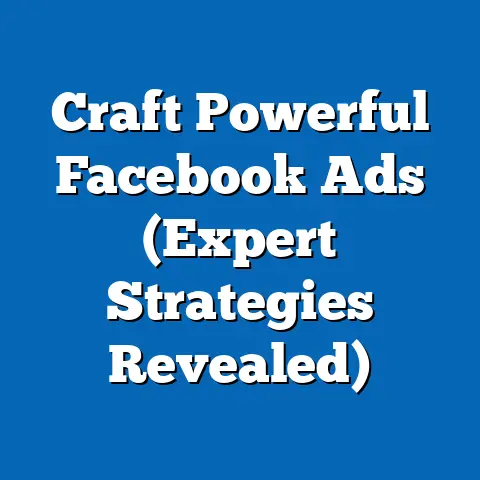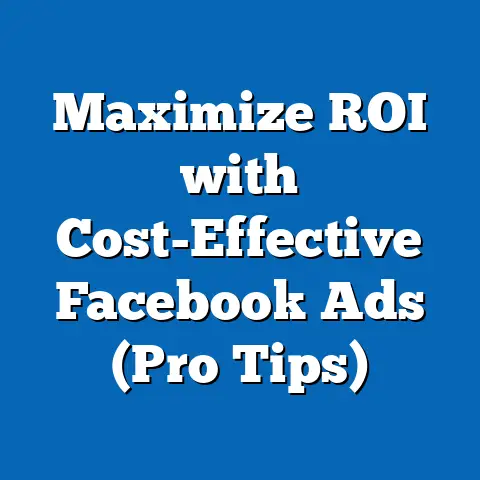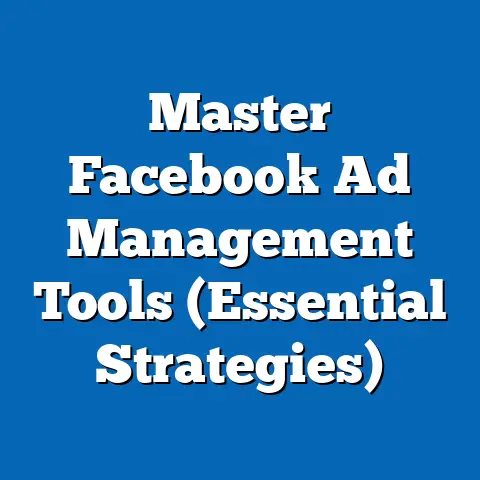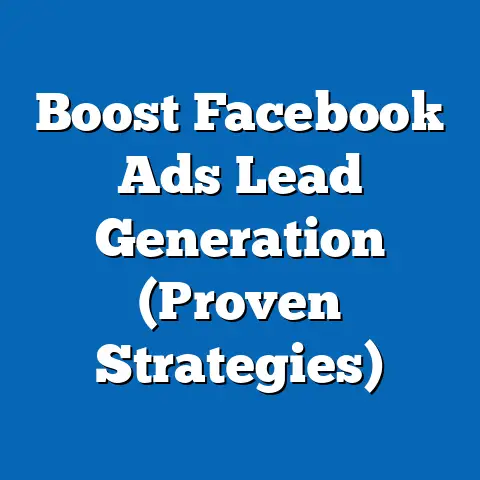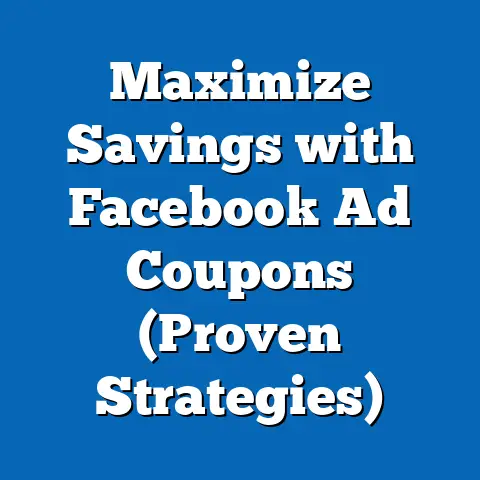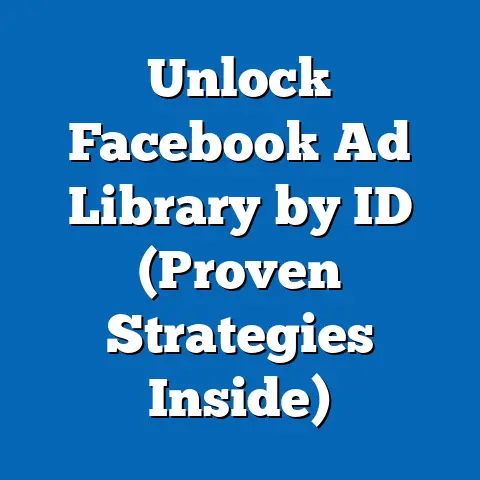Master Facebook Ad Search (Unlock Powerful Strategies)
I’ve always been fascinated by the transformative power of renovation. Think about it: taking something old, tired, or simply not working, and turning it into something beautiful, functional, and perfectly suited to its purpose. I remember helping my neighbor, Sarah, renovate her old Victorian house. It was a disaster at first. Budget overruns piled up faster than dust bunnies, we uncovered some… interesting structural issues (let’s just say squirrels had impeccable taste in insulation), and there were days when we wondered if we’d ever see the light at the end of the tunnel. But with careful planning, a solid strategy, and a willingness to adapt to the unexpected, we transformed that dilapidated house into a stunning home.
That experience, believe it or not, taught me a lot about digital marketing, especially Facebook advertising. Just like a renovation, a successful Facebook ad campaign requires a clear blueprint, a well-defined strategy, and the ability to pivot when things don’t go as planned. That blueprint, in the world of Facebook ads, is Facebook Ad Search.
In this guide, I’m going to walk you through everything you need to know to master Facebook Ad Search. We’ll cover the fundamentals, dive into advanced strategies, and explore how you can leverage this powerful tool to achieve transformative results for your business. Think of me as your digital marketing contractor, here to help you build the Facebook ad campaign of your dreams.
Understanding Facebook Ads – The Foundation of Your Strategy
Before we jump into the nitty-gritty of Facebook Ad Search, let’s take a step back and make sure we have a solid foundation. Facebook ads are, at their core, a way to reach a highly targeted audience with your message. But the beauty of Facebook lies in its incredible diversity of ad formats and targeting options.
Here are some common types of Facebook ads you should be familiar with:
- Image Ads: These are the simplest form of Facebook ads, featuring a single image and accompanying text. They’re great for showcasing products, announcing promotions, or driving traffic to your website.
- Video Ads: Video ads are incredibly engaging and can be used to tell your brand story, demonstrate a product, or share testimonials. They tend to have higher engagement rates than image ads.
- Carousel Ads: Carousel ads allow you to showcase multiple images or videos in a single ad unit. This is perfect for highlighting different features of a product, telling a story, or showcasing a range of offerings.
- Collection Ads: Collection ads are designed for e-commerce businesses, allowing users to browse and purchase products directly from the ad.
- Lead Generation Ads: These ads are designed to collect leads directly on Facebook, without requiring users to visit your website. They’re great for building your email list or gathering information for sales follow-up.
The Facebook Ads Manager: Your Central Command Center
All of these ad types are managed through the Facebook Ads Manager. Think of the Ads Manager as the control panel for your entire Facebook advertising operation. It’s where you create campaigns, define your target audience, set your budget, design your ads, and track your results.
I remember the first time I logged into the Ads Manager – it was overwhelming! There were so many options, settings, and metrics that I felt completely lost. But don’t worry, it gets easier with practice. The key is to take it one step at a time and focus on understanding the core concepts.
Audience Targeting: Reaching the Right People
One of the most powerful features of Facebook advertising is its ability to target specific audiences based on a wide range of criteria. You can target people based on:
- Demographics: Age, gender, location, education, job title, and more.
- Interests: Hobbies, passions, and interests they’ve expressed on Facebook.
- Behaviors: Purchase behavior, device usage, travel habits, and more.
- Custom Audiences: These are audiences you create based on your own data, such as email lists, website visitors, or app users. This is where things get really powerful.
- Lookalike Audiences: These are audiences that Facebook creates based on your custom audiences, targeting people who are similar to your existing customers.
Key Takeaway: Understanding the different types of Facebook ads, the Facebook Ads Manager, and the power of audience targeting is crucial for building a successful advertising strategy. Before moving on, familiarize yourself with these concepts – they’ll be the foundation for everything else we discuss.
Keyword Research – Laying the Groundwork for Success
Now, let’s get to the heart of this guide: Keyword Research for Facebook Ads. I know what you might be thinking: “Keywords? Isn’t that an SEO thing?” Well, yes and no. While keywords are traditionally associated with search engine optimization, they also play a vital role in Facebook advertising.
Think of it this way: On Google, people actively search for information using keywords. On Facebook, people are passively scrolling through their feeds. Your job is to interrupt that scroll and grab their attention. But how do you do that effectively? By understanding what your target audience is interested in, talking about, and searching for within the Facebook ecosystem.
Keywords vs. Interests: What’s the Difference?
While Facebook’s audience targeting options allow you to target people based on their “interests,” these are often broad and generic. Keyword research allows you to dig deeper and uncover more specific and relevant terms that your target audience is using.
For example, instead of targeting people interested in “fitness,” you might discover that your target audience is actively searching for information about “high-intensity interval training,” “vegan protein powder,” or “yoga for beginners.”
Tools and Techniques for Keyword Discovery
So, how do you find these valuable keywords? Here are a few tools and techniques I’ve found helpful:
- Facebook Search Bar: This is the simplest and most direct way to discover keywords. Start by typing in broad terms related to your product or service and see what suggestions Facebook provides. Pay attention to the auto-complete suggestions, related searches, and popular groups or pages that appear.
- Facebook Audience Insights: This tool provides valuable insights into the demographics, interests, and behaviors of your target audience. You can use it to identify the topics, pages, and groups that your audience is most engaged with.
- Competitor Analysis: Take a look at your competitors’ Facebook ads and see what keywords they’re using in their ad copy and targeting. This can give you a good starting point for your own keyword research.
- Social Listening Tools: Tools like Brandwatch, Mention, and Sprout Social can help you monitor conversations and trends on social media, identifying the keywords and topics that are most relevant to your target audience.
- Google Keyword Planner (with a Twist): While primarily used for SEO, the Google Keyword Planner can also provide valuable insights into the search terms that people are using outside of Facebook. You can then adapt these terms to the Facebook context.
Evaluating Keyword Performance
Once you’ve identified a list of potential keywords, it’s important to evaluate their performance and determine which ones are most effective for your Facebook ads. Here are a few metrics to track:
- Relevance: How relevant is the keyword to your product or service?
- Search Volume: How many people are searching for this keyword on Facebook? (This is harder to track directly, but you can infer it based on engagement and reach.)
- Competition: How many other advertisers are targeting this keyword?
- Cost-Effectiveness: How much does it cost to target this keyword?
- Conversion Rate: How well does this keyword convert into leads or sales?
Adjusting Strategies Based on Analytics
The key to successful keyword research is to continuously monitor your results and adjust your strategies accordingly. If a keyword isn’t performing well, don’t be afraid to replace it with a new one. Experiment with different variations of your keywords, and always be on the lookout for new and emerging trends.
Key Takeaway: Keyword research is a critical component of a successful Facebook advertising strategy. By understanding what your target audience is interested in and searching for, you can create more relevant and engaging ads that drive results.
Crafting Compelling Ad Copy – The Heart of Your Campaign
You’ve done your keyword research, you know your target audience, now it’s time to write some killer ad copy! I like to think of ad copy as the heart of your Facebook ad campaign. It’s what grabs people’s attention, tells them what you have to offer, and motivates them to take action.
But crafting effective ad copy isn’t as easy as it sounds. You need to be creative, persuasive, and concise – all while staying within Facebook’s character limits.
Elements of Effective Ad Copy
Here are some key elements to keep in mind when writing your Facebook ad copy:
- Attention-Grabbing Headline: Your headline is the first thing people will see, so it needs to be attention-grabbing and relevant to their interests. Use strong verbs, numbers, and questions to pique their curiosity.
- Persuasive Language: Use persuasive language to highlight the benefits of your product or service and convince people to take action. Focus on the “what’s in it for me” aspect.
- Clear Call to Action: Tell people exactly what you want them to do. Use clear and concise calls to action like “Shop Now,” “Learn More,” or “Sign Up Today.”
- Relevance: Make sure your ad copy is relevant to your target audience and the keywords you’re targeting.
- Conciseness: Get to the point quickly and avoid using jargon or overly technical language.
- Emotional Appeal: Tap into your audience’s emotions by telling a story, highlighting their pain points, or inspiring them with a vision of a better future.
Examples of Successful Facebook Ad Copy
To give you a better idea of what effective ad copy looks like, here are a few examples:
-
Example 1: E-commerce
- Headline: 50% OFF All Summer Dresses!
- Body: Stay cool and stylish this summer with our collection of trendy dresses. Shop now and get 50% off your entire order!
- Call to Action: Shop Now
-
Example 2: Lead Generation
-
Headline: Free Guide: 5 Secrets to a Perfect Lawn
- Body: Want a lush, green lawn that’s the envy of the neighborhood? Download our free guide and discover the secrets to a perfect lawn!
- Call to Action: Download Now
-
Example 3: Brand Awareness
-
Headline: Discover the Power of [Your Brand]
- Body: At [Your Brand], we’re passionate about helping you achieve your goals. Learn more about our products and services and see how we can make a difference in your life.
- Call to Action: Learn More
Example 1: E-commerce
- Headline: 50% OFF All Summer Dresses!
- Body: Stay cool and stylish this summer with our collection of trendy dresses. Shop now and get 50% off your entire order!
- Call to Action: Shop Now
-
Example 2: Lead Generation
-
Headline: Free Guide: 5 Secrets to a Perfect Lawn
- Body: Want a lush, green lawn that’s the envy of the neighborhood? Download our free guide and discover the secrets to a perfect lawn!
- Call to Action: Download Now
-
Example 3: Brand Awareness
-
Headline: Discover the Power of [Your Brand]
- Body: At [Your Brand], we’re passionate about helping you achieve your goals. Learn more about our products and services and see how we can make a difference in your life.
- Call to Action: Learn More
Example 2: Lead Generation
Headline: Free Guide: 5 Secrets to a Perfect Lawn
Example 3: Brand Awareness
Headline: Discover the Power of [Your Brand]
A/B Testing for Ad Copy
The best way to determine what works best for your target audience is to A/B test different versions of your ad copy. A/B testing involves creating two or more versions of your ad copy, each with a slight variation, and then running them simultaneously to see which one performs better.
You can A/B test different headlines, body text, calls to action, and even different tones of voice. The key is to only change one variable at a time so you can accurately measure the impact of each change.
Key Takeaway: Compelling ad copy is essential for grabbing attention, conveying your message, and driving results. Use strong headlines, persuasive language, clear calls to action, and A/B test your copy to optimize performance.
Design and Visual Elements – Creating the Right Aesthetic
While compelling ad copy is crucial, it’s only half the battle. In the visually-driven world of Facebook, your ad’s design and visual elements play a critical role in capturing attention and driving engagement.
Think of your ad’s visuals as the storefront of your business. If it’s cluttered, outdated, or unappealing, people are likely to scroll right past. But if it’s clean, modern, and visually engaging, it will grab their attention and entice them to learn more.
The Impact of High-Quality Images and Videos
High-quality images and videos are essential for creating effective Facebook ads. Avoid using blurry, pixelated, or poorly lit images. Instead, opt for professional-quality visuals that are visually appealing and relevant to your target audience.
Here are a few tips for selecting the right visuals for your Facebook ads:
- Use High-Resolution Images: Make sure your images are at least 1200 x 628 pixels to avoid pixelation.
- Choose Relevant Images: Select images that are relevant to your product or service and that resonate with your target audience.
- Showcase Your Product: If you’re selling a product, showcase it in a visually appealing way. Use lifestyle shots that show people using and enjoying your product.
- Use Videos to Tell Your Story: Videos are a great way to tell your brand story, demonstrate a product, or share testimonials. Keep your videos short and engaging.
Design Principles for Enhanced Ad Effectiveness
In addition to using high-quality visuals, it’s also important to apply basic design principles to enhance the effectiveness of your Facebook ads. Here are a few key principles to keep in mind:
- Color Psychology: Use colors strategically to evoke certain emotions and create a desired mood. For example, blue is often associated with trust and reliability, while red is associated with excitement and passion.
- Composition: Pay attention to the composition of your visuals. Use the rule of thirds to create a visually balanced and appealing layout.
- Branding Consistency: Maintain branding consistency across all of your Facebook ads. Use your brand colors, fonts, and logo to create a cohesive and recognizable brand identity.
- Whitespace: Don’t overcrowd your visuals with too much text or too many elements. Use whitespace to create a clean and uncluttered look.
- Call to Action Placement: Make sure your call to action is prominently displayed and easy to find.
Tips for Creating Visually Appealing Ads
Here are a few additional tips for creating visually appealing Facebook ads:
- Use Eye-Catching Graphics: Use eye-catching graphics and animations to grab people’s attention as they scroll through their feeds.
- Tell a Story: Use visuals to tell a story and connect with your audience on an emotional level.
- Show Social Proof: Use visuals to showcase social proof, such as customer testimonials or user-generated content.
- Keep it Simple: Don’t overcomplicate your visuals. Keep it simple and focus on conveying your message clearly and concisely.
Key Takeaway: Design and visual elements are crucial for capturing attention and driving engagement on Facebook. Use high-quality images and videos, apply basic design principles, and keep your visuals clean, simple, and visually appealing.
Budgeting and Bidding Strategies – Financial Planning for Success
You’ve got your ad copy and visuals nailed down, now it’s time to talk about money! Setting a budget and choosing the right bidding strategy are essential for maximizing your ROI and achieving your advertising goals.
Setting a Budget for Facebook Ad Campaigns
When setting a budget for your Facebook ad campaigns, there are two main options:
- Daily Budget: This is the average amount you’re willing to spend each day on your ad campaign.
- Lifetime Budget: This is the total amount you’re willing to spend on your ad campaign over its entire duration.
Which option is right for you? It depends on your goals and your level of experience. If you’re just starting out, I recommend using a daily budget so you can monitor your performance closely and make adjustments as needed.
Factors to Consider When Setting Your Budget
Here are a few factors to consider when setting your budget:
- Your Goals: What are you trying to achieve with your Facebook ads? Are you trying to generate leads, drive sales, or build brand awareness?
- Your Target Audience: How large is your target audience? The larger your audience, the more you’ll need to spend to reach them.
- Your Industry: How competitive is your industry? The more competitive your industry, the more you’ll need to spend to stand out.
- Your Ad Quality: How relevant and engaging are your ads? The higher the quality of your ads, the lower your cost per click (CPC) will be.
Bidding Strategies: Automatic vs. Manual
Facebook offers a variety of bidding strategies to help you optimize your ad spend. The two main categories of bidding strategies are:
- Automatic Bidding: With automatic bidding, Facebook automatically sets your bids to get you the most results for your budget. This is a good option for beginners or for campaigns where you’re not sure what bids to set.
- Manual Bidding: With manual bidding, you set your bids manually. This gives you more control over your ad spend, but it also requires more expertise and monitoring.
Common Bidding Strategies
Here are a few common bidding strategies you can use on Facebook:
- Cost Per Click (CPC): You pay each time someone clicks on your ad. This is a good option for driving traffic to your website.
- Cost Per Thousand Impressions (CPM): You pay for every 1,000 times your ad is shown. This is a good option for building brand awareness.
- Cost Per Acquisition (CPA): You pay each time someone takes a desired action, such as making a purchase or signing up for a newsletter. This is a good option for generating leads or driving sales.
Optimizing Ad Spend for the Best ROI
The key to optimizing your ad spend is to continuously monitor your performance and make adjustments as needed. Here are a few tips for optimizing your ad spend:
- Track Your Results: Use Facebook’s analytics tools to track your key performance indicators (KPIs), such as click-through rates (CTR), conversion rates, and cost per acquisition (CPA).
- Pause Underperforming Ads: If an ad isn’t performing well, pause it and focus your budget on ads that are generating results.
- Scale Successful Ads: If an ad is performing well, scale it by increasing your budget or targeting a larger audience.
- A/B Test Your Bids: Experiment with different bidding strategies to see which ones generate the best results for your budget.
Key Takeaway: Setting a budget and choosing the right bidding strategy are essential for maximizing your ROI on Facebook. Consider your goals, target audience, and industry when setting your budget, and continuously monitor your performance and make adjustments as needed.
Analyzing Performance – Measuring Success and Adapting Strategies
You’ve launched your Facebook ad campaign, the ads are running, and the money is flowing. But how do you know if your campaign is actually working? That’s where performance analysis comes in.
Analyzing your Facebook ad performance is crucial for understanding what’s working, what’s not, and how you can improve your results. It’s like getting a report card on your marketing efforts.
Key Performance Indicators (KPIs) for Facebook Ads
Here are some key performance indicators (KPIs) you should be tracking:
- Impressions: The number of times your ad was shown.
- Reach: The number of unique people who saw your ad.
- Click-Through Rate (CTR): The percentage of people who saw your ad and clicked on it.
- Cost Per Click (CPC): The amount you paid for each click on your ad.
- Conversion Rate: The percentage of people who clicked on your ad and then took a desired action, such as making a purchase or signing up for a newsletter.
- Cost Per Acquisition (CPA): The amount you paid for each desired action.
- Return on Ad Spend (ROAS): The amount of revenue you generated for every dollar you spent on advertising.
Tracking and Analyzing Ad Performance Data
Facebook’s Ads Manager provides a wealth of data to help you track and analyze your ad performance. You can use this data to:
- Identify Underperforming Ads: See which ads are generating the fewest clicks, conversions, or sales.
- Optimize Your Targeting: See which audiences are responding best to your ads.
- Improve Your Ad Copy and Visuals: See which headlines, body text, and visuals are driving the most engagement.
- Adjust Your Bidding Strategies: See which bidding strategies are generating the best results for your budget.
Strategies for Iterating on Campaigns
Based on your performance data, you can iterate on your campaigns to improve your results. Here are a few strategies you can use:
- Pause Underperforming Ads: If an ad isn’t performing well, pause it and focus your budget on ads that are generating results.
- Adjust Your Targeting: If your ads aren’t reaching the right people, adjust your targeting to focus on a more relevant audience.
- Improve Your Ad Copy and Visuals: If your ads aren’t generating enough clicks or conversions, experiment with different headlines, body text, and visuals.
- Test Different Bidding Strategies: Experiment with different bidding strategies to see which ones generate the best results for your budget.
- Scale Successful Ads: If an ad is performing well, scale it by increasing your budget or targeting a larger audience.
Key Takeaway: Analyzing your Facebook ad performance is crucial for understanding what’s working, what’s not, and how you can improve your results. Track your KPIs, use Facebook’s analytics tools to analyze your data, and iterate on your campaigns based on your findings.
Advanced Strategies – Unlocking the Full Potential of Facebook Ads
Now that we’ve covered the basics, let’s dive into some advanced strategies that can help you unlock the full potential of Facebook ads.
Retargeting: Reaching Potential Customers Who Have Already Interacted With Your Brand
Retargeting is a powerful strategy that allows you to reach potential customers who have already interacted with your brand, such as website visitors, app users, or people who have engaged with your Facebook page.
By retargeting these potential customers, you can increase your chances of converting them into leads or sales. After all, they’ve already shown an interest in your brand, so they’re more likely to be receptive to your message.
Dynamic Ads: Personalizing Ads Based on User Behavior
Dynamic ads are a type of retargeting ad that allows you to personalize your ads based on user behavior. For example, if someone viewed a specific product on your website, you can show them an ad for that product on Facebook.
Dynamic ads are highly effective because they’re relevant to the user’s interests and they remind them of the products they were considering.
Integrating Facebook Ads with Other Marketing Channels
Facebook ads can be even more effective when integrated with other marketing channels, such as email marketing, content marketing, and search engine optimization (SEO).
For example, you can use Facebook ads to drive traffic to your website, and then use email marketing to nurture those leads and convert them into customers. You can also use content marketing to create valuable content that attracts potential customers to your website, and then use Facebook ads to promote that content.
Leveraging Facebook’s Audience Insights Tool
Facebook’s Audience Insights tool provides valuable insights into the demographics, interests, and behaviors of your target audience. You can use this tool to:
- Refine Your Targeting: Identify the specific interests and behaviors that are most relevant to your target audience.
- Create Lookalike Audiences: Create lookalike audiences based on your existing customers or website visitors.
- Discover New Audiences: Identify new audiences that you may not have considered before.
Key Takeaway: Advanced strategies like retargeting, dynamic ads, integrating Facebook ads with other marketing channels, and leveraging Facebook’s Audience Insights tool can help you unlock the full potential of your Facebook ads and achieve even greater results.
Conclusion: Transforming Your Facebook Advertising Strategy
We’ve covered a lot of ground in this guide, from the fundamentals of Facebook ads to advanced strategies for optimizing your campaigns. Just like a home renovation, mastering Facebook Ad Search requires a clear blueprint, a well-defined strategy, and the ability to adapt to the unexpected.
I hope you found this guide helpful and that it has inspired you to take your Facebook advertising strategy to the next level. Remember, the key to success is to embrace the learning process and continuously adapt your strategies for optimal results.
Just as Sarah’s renovated Victorian house breathed new life into the neighborhood, mastering Facebook Ad Search can lead to transformative outcomes for your business. So, go out there, experiment, and see what you can achieve!
Call to Action: Engage Your Audience
Now it’s your turn! Share your experiences with Facebook ads, ask questions, or comment on the strategies discussed in this article. Let’s learn and grow together!
And if you want to stay up-to-date on the latest tips and insights into digital marketing and Facebook advertising, subscribe to my newsletter or follow me on social media. I’m always sharing new strategies and techniques to help you succeed.

